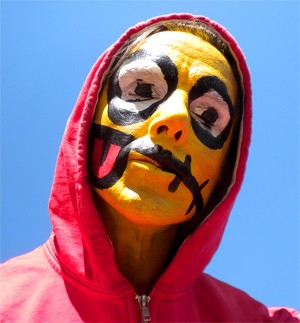Rolf Saint-Agnès, a French artist, moved to New York City in 1991 and lived there for 10 years near Soho, where he breathed the same air as Roy Lichtenstein and Andy Warhol.
Hence, it was not surprising that he chose to express himself through pop art, portraying different aspects of his adopted city with a mixture of irony and affection, using his scathing sense of humor to depict the shortcomings of a consumer society.At that time, the AIDS epidemic was raging in New York and Rolf offered his services to the NYC Department of Health as he wanted to participate in an awareness campaign. According to the artist, the message had to be optimistic so he created two happily-embracing condoms that were reproduced on post-cards and circulated throughout New York by the thousands. The campaign was a great success and was spoken about abroad, with the French weekly magazine, Paris Match, even dedicating a page to Rolf’s action.
In addition, the artist has always been interested in environment-related issues and gradually, as he became more concerned about the state of the planet, his style evolved and became distinctly surrealist. At this point, he decided to abandon his New York life-style and crossed the United States to settle in a wood cabin without electricity or heating in Mendocino National forest, Northern California. He lived there for a year, drawing inspiration from the mountains, forests and wild animals that crossed his path. It was also a year of intense introspection, which he used to assess his artistic activity during his stay in the United States.This, Rolf found to be very positive. Despite his young age, he had built himself a solid reputation in New York, the capital of contemporary art. Exhibits of his work were all much remarked, from that in Gallery One, Soho to a show sponsored by Japan Airlines at JFK Airport. Other shows were held at the Jacob Trapp Gallery in Summit, New Jersey, at 450 Broadway Gallery and at the Art Expo in the Jacob Javits Center. Rolf was also involved in several anti-AIDS campaigns, such as that organized by the NYC Department of Health, one conceived by the Arthur Ashe Foundation and by DIFFA, New York. The New England Center for Contemporary Art had selected one of his drawings for their permanent exhibition and he had been asked to paint murals for a number of restaurants in New York and Florida. Moreover, he had collaborated with New York Cares by doing a mural in Washington Irving High School for their second Coverall Ball, and had also illustrated various magazine covers. Thus, over an almost 10-year period, he had acquired a faithful group of American clients. In parallel, he also came to be known in Sweden where he had numerous shows at the Alex Wiberg Gallery in Stockholm and was chosen to participate in Stockholm’s Art Fair.Rolf returned to Paris, France, in 2001 and had shows at Galerie S21, and with Sabine, Photographic Management, as well as at Epi Plage, Ramatuelle, near Saint Tropez.
However, he soon got tired of hectic city life and moved with his wife and children to a small town near Toulouse in South-Western France, where he found new inspiration and changed his style. He has totally abandoned the very detailed way he had of painting in the beginning and now paints in a more liberated fashion. His paintings, full of color and movement, portray his sensitivity and imagination. They have become an important mode of expression, allowing him to communicate his deepest emotions, and leave no-one indifferent.

